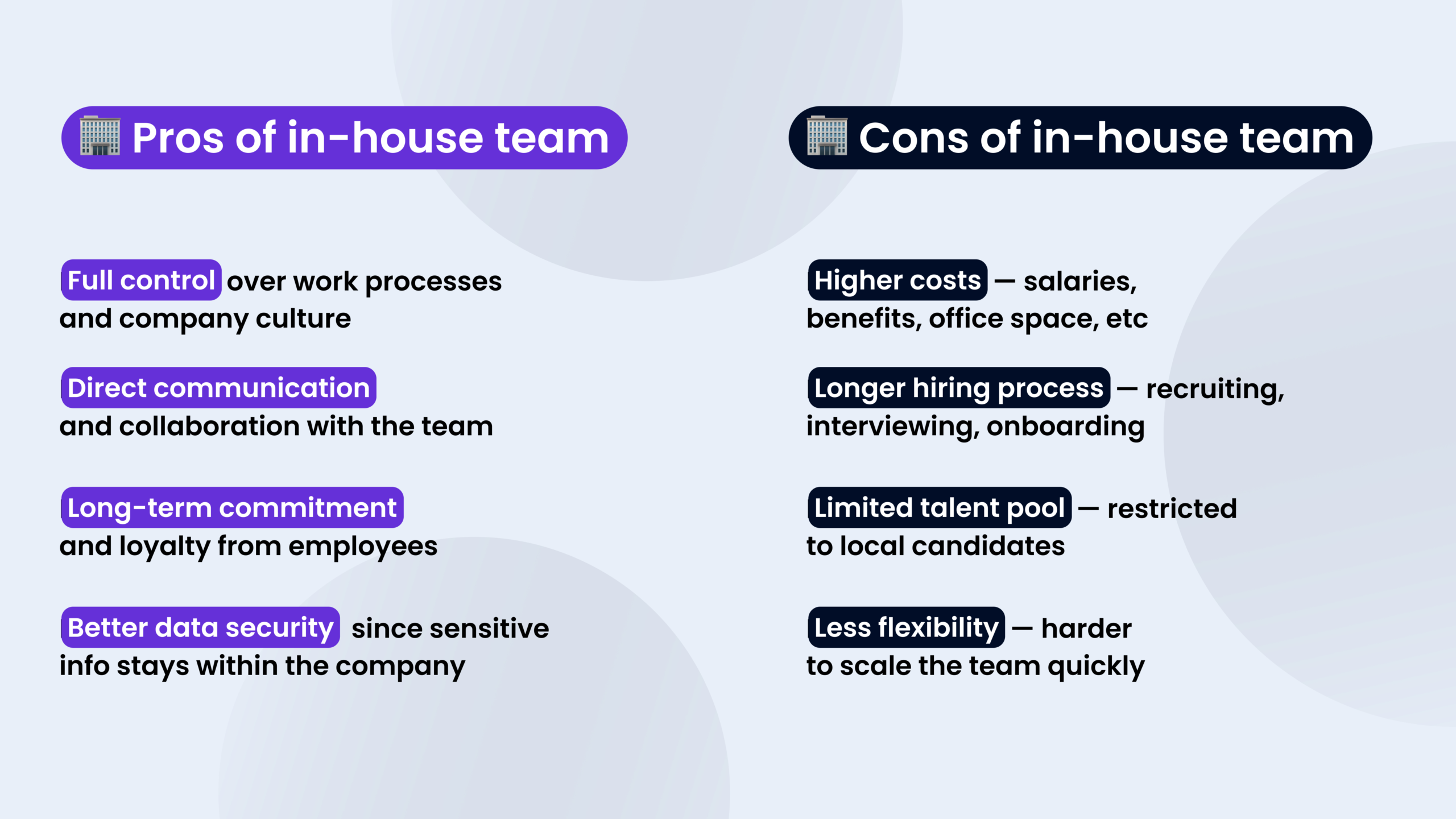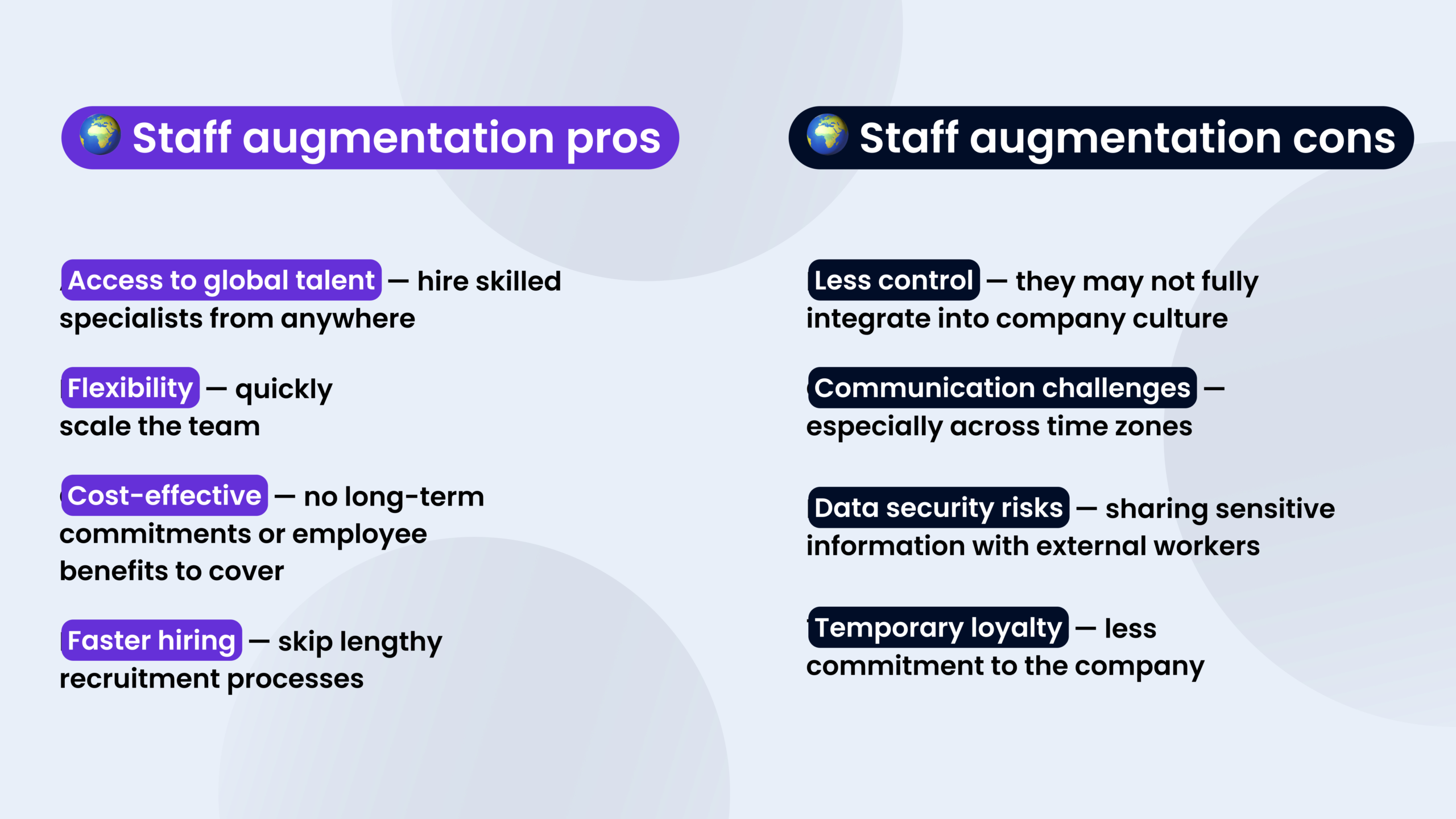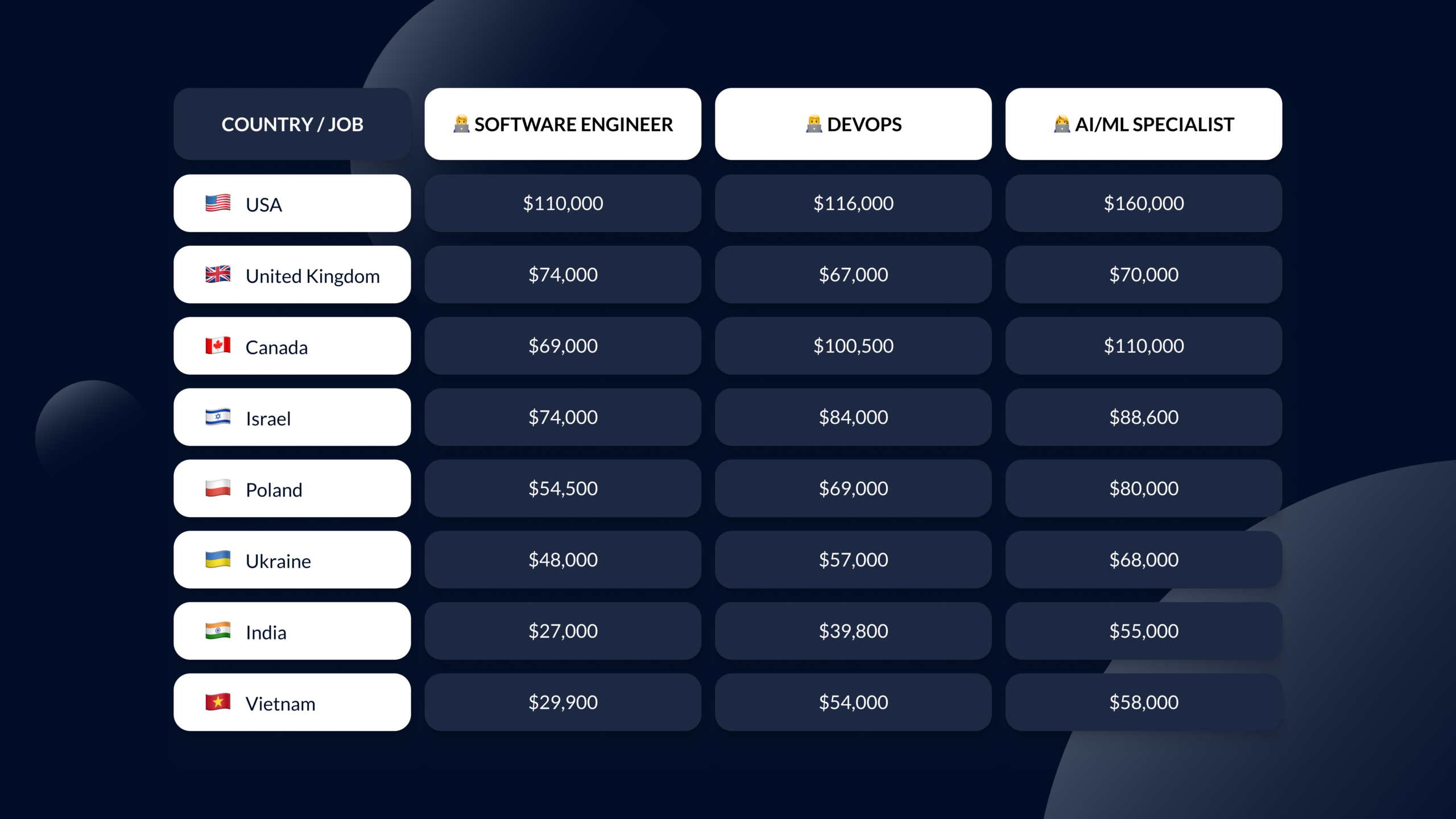
What would you better do: Hire an IT specialist by yourself or choose an IT outstaffing agency to do all the recruitment and hiring for you? MWDN to the rescue! Let’s see which option is better for your particular case because none of them are universal solutions.
Content:
- You decided to hire IT specialists by yourself—your pros and cons.
- You opted for out staffing agency. What to expect?
- Comparing the costs: How much does it cost to hire an IT specialist?
- Let’s examine your particular case now…
- Summing up
What about other hiring options? In this article, we won’t cover freelance platforms and traditional outsourcing, as these options have quite obvious flaws. With traditional outsourcing, you delegate whole projects and usually don’t have much control over the work done. Plus, outsourcing companies usually demand very concrete and strict requirements for the project, and they are not your choice if you don’t have any yet. Freelancers, on the other hand, are not entirely reliable. You can get lucky and get a top specialist at a fraction of the cost, but with the same probability, you can hire a fake account (and you never know who’s behind it) that won’t do the job properly.
So, back to the in-house hiring and outstaffing.
You decided to hire IT specialists by yourself—your pros and cons.
The people you’re about to hire and come to the office with are like a crew for a long voyage. Not exactly the family, but people who understand the company’s peculiarities, share its wins and losses, and help it to grow. They create a sense of stability and loyalty. They become, if not friends, then good pals who brainstorm together, accompanying each other’s experiences, sometimes work extra hours before the release, and help each other. There’s a rhythm that develops when you work side by side, even if that “side by side” happens over Slack or Zoom.
In-house specialists who have all the social benefits of full-time employment are often more invested in the strategic development of your business. They are here not just to close tickets; they are truly interested in where the company is heading. Over time, they become the key asset of any business, becoming a database of internal knowledge about systems, processes, and those unwritten rules that no one bothers to document but somehow keep everything running. All these elements create a strong sense of team identity, something that’s hard to replicate with freelancers or short-term hires.

But of course, full-time employment is not always the best choice for companies and businesses worldwide. Hiring in-house means committing not just to salaries, but to benefits, equipment, and everything else that comes with having someone on the payroll. Great talent doesn’t come cheap, especially in tech. And then there’s the time it takes — sifting through resumes, interviewing candidates, and onboarding new team members — it’s a process that can’t be rushed.
Flexibility is another hurdle. If workloads spike or dip unexpectedly, an in-house team might feel too large or too small for the moment, and adjusting quickly isn’t always an option. There’s also the risk of burnout if the team is stretched too thin, and when there’s a skill gap, you can’t simply swap someone out the way you could with a contractor — you either train or hire IT specialist again.
Still, for many tech companies, having a dedicated, in-house team creates a kind of continuity that’s hard to beat. It’s about more than just filling seats — it’s about building something together with people who are fully invested in the journey.
You opted for out staffing agency. What to expect?
So, you decided to go with an outstaffing agency — a solid choice, especially if you need flexibility or a wider pool of applicants to choose from. But if you have never worked with an out staffing agency before, you might wonder what to expect and what the processes look like when it comes to business.
Staff augmentation’s number one benefit is its speed. This cooperation model offers faster hiring solutions compared to traditional hiring. You give job requirements, and in a couple of weeks (or sometimes – days), you get a list of best-fitting applicants. The recruitment process is not as hard or long as with traditional hiring, so you get a specialist ready to deload your team much quicker.
Another positive aspect of outstaffing is its flexibility. You can have a fully dedicated team for five years. Or a temporary high-skilled assistance for a part-time position. It’s like having a remote bench of specialists ready when you are.
The key benefit, though, of so many companies choosing outstaffing agencies is that they give you access to unique talent and highly specialized skills. Need someone fluent in a niche programming language or with rare cloud expertise? Agencies often have people with very specific tech stacks — the kind you might struggle to find on your own.

Of course, it’s not all smooth sailing. One of the trickier parts is team integration. These developers might be talented, but they’re not sitting in your office or steeped in your company’s culture. It takes effort to build communication flows and make sure they’re aligned with your processes, so they don’t feel like outsiders working on your project instead of with your team.
There’s also the question of loyalty. Outstaffed team members are technically employed by the agency, not you. They’ll do their job well, but they might not have the same long-term buy-in or emotional investment as a full-time employee. It’s more about the task at hand than the company’s bigger mission.
And while costs are usually more predictable than direct hiring, you’re still paying agency fees on top of the developer’s salary. It can be more affordable than building a full-time team, but it’s not always the cheapest route.
So, what should you expect? Agility, quick access to talent, and fewer HR headaches — but with the need for clear communication and a bit of extra effort to make these external team members feel like part of the fold.
It’s a trade-off, like anything else. The key is knowing what you need right now — speed and flexibility, or long-term stability — and choosing the setup that moves your projects forward.
Comparing the costs: How much does it cost to hire an IT specialist?
Hiring an IT specialist can hit your wallet pretty differently depending on whether you go the in-house route or work with a staff augmentation company. So, what’s actually cheaper? Let’s talk.
When you hire in-house, the salary is just the start. You’ve got benefits, health insurance, office equipment, and software licenses — not to mention the time and money spent recruiting and onboarding. It’s a long-term deal. Even if your workload drops, you can’t just hit pause on full-time employees. They’re part of the team, and that comes with commitment — and costs.
Now, with staff augmentation, it’s a whole other story. You pay for the work — either by the hour or month — and that’s pretty much it. No benefits, no office costs, no recruitment headaches. The agency handles all that. If your project suddenly expands or slows down, you just scale the team down. It’s flexible and fast.
So, which is more affordable?
If you’ve got short-term projects or need specific skills on the fly, staff augmentation usually wins — fewer strings attached, fewer surprise costs. But if you’re building a solid, core team for the long journey, in-house might save you money over time — plus, those employees grow with the company and get invested in its future.
At the end of the day, it’s about what you need right now. Flexibility and speed? Outstaff. Stability and long-term loyalty? In-house. The price tag depends on how long you’re planning to keep those extra hands on deck.
How else can staff augmentation help you save money?
If you choose to hire an IT specialist with a staff augmentation company, you can choose the region for recruitment. This is the place for yet another, and quite dramatic, cost cut. For example, if your company’s head office is in Los Angeles or Tel Aviv, you can save up to 60% on direct labor costs by simply choosing offshore vendors who offer tech talent from regions with lower salaries.
Here are some average annual salaries in US dollars for software engineers, DevOps engineers, and AI/ML specialists in different countries:

At MWDN, we specialize in tech talent from Eastern Europe, yet, of course, we can search for IT specialists for hire in other regions as well.
Let’s examine your particular case now…
Here are a couple of examples that might relate to you and the hiring solutions we would recommend.
1. Israeli-based healthcare company needing software developers
Let’s say you’re a healthcare company in Israel developing a new patient app or a data analytics platform for hospitals. You need software developers, but the local tech talent pool is expensive and competitive — plus, the project timeline is a bit unclear.
In this case, staff augmentation could actually be a smart move. Why?
- Access to global talent: You can hire skilled developers from Eastern Europe, for example, without waiting months to hire locally.
- Scalability: Healthcare projects often start small and then expand as features roll out. Augmentation lets you adjust the team size as the project evolves.
- Speed: You don’t have to deal with long recruitment cycles — the agency sends you pre-vetted candidates ready to start.
- Cost: Hiring from Eastern Europe as an Israeli company can save you up to 30% on direct labor costs. As you’ve seen above, the average salary of an Israeli-based software developer is $74,000, while in Ukraine, it’s just $48,000.
You still keep a small core in-house team for security-sensitive work, but the augmented developers handle the bulk of coding and feature building. It’s a flexible, cost-effective setup while maintaining control over critical aspects.
2. Lithuanian telecommunications company looking for system administrators
Now, let’s switch to the telecom company in Lithuania. You’re upgrading your infrastructure and need system administrators to handle cloud migrations, server maintenance, and network security.
Here, in-house hiring might actually be the better choice. Why?
- Ongoing work: Unlike a one-time app build, system administration is a continuous process — networks need monitoring, and security requires constant updates.
- Company knowledge: Your system admins need to understand your specific tech stack and infrastructure deeply — something that’s harder to achieve with short-term staff.
- Data security: Telecom companies deal with tons of sensitive data, so having permanent employees, fully integrated into your security protocols, is safer.
- Location: System administrators might be required to work with actual servers that are situated on your premises. Better to have someone who can be there in 15 minutes, not a couple of days.
While you could use staff augmentation for extra hands during a major rollout, the core team should ideally be in-house to ensure stability and expertise in your systems.
Summing up
As you see, it all depends, and what works for one company won’t work for the other. Want to make sure staff augmentation will become your competitive advantage and is the best option for your business? Contact MWDN for a free consultation and learn how staff augmentation can help you save time, money, and resources!

